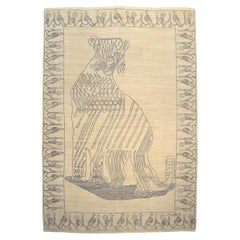Neutral Leopardess
2010s Persian Modern Persian Rugs
Wool
People Also Browsed
2010s Persian Mid-Century Modern Persian Rugs
Wool
2010s Persian Modern Persian Rugs
Silk, Wool
21st Century and Contemporary Persian Primitive Persian Rugs
Wool, Silk
2010s Turkish Art Deco Persian Rugs
Wool, Silk
Bahram Shabahang for sale on 1stDibs
The art of Persian rug design has long been in Bahram Shabahang’s blood. Born in Iran but now based in Milwaukee, Wisconsin, Shabahang can trace his family history back to 16th-century Iran when an ancestor once oversaw carpet weavers in the workshop of King Tahmass Safavieh. Today, Shabahang’s Persian rugs and carpets are distinctly more modern in style, albeit produced by using ancient hand-woven techniques.
The story of Shabahang’s journey to becoming a prolific Persian rug designer begins back in 1972 in the bazaars of Isfahan, Iran. There, he met Geoffrey Orley, an American who was searching for “the world’s greatest carpets.” As Orley told Detroit Design magazine: “Somebody with a big Afro showed me a great carpet. He took me back to his home, and that was [Bahram] Shabahang.”
Having discovered that they shared an affinity for the distinctive artistry behind Persian rugs, Shabahang and Orley became lifelong friends and forged a business partnership, forming the rug and carpet company Orley Shabahang in 1973. At first, they focused mainly on importing and restoring antique Persian carpets, but by 2000, Shabahang wanted to create his own collection of modern and unique rug designs.
With the support of Orley, Shabahang designed several collections of new “Persian revival” carpets. Shabahang, who holds master's degrees in architecture and urban planning, relied on his drafting skills to create the Maps series of rugs, which featured maps of San Francisco, Rome, South America and Washington, D.C. Additional works include the Architecture collection and Persian, Indian and Caucasian rugs with minimalist, abstract and animal designs.
Shabahang’s rugs have been shown at galleries and exhibitions worldwide, including the 30th annual International Contemporary Furniture Fair (ICFF) in New York in 2018. Publications such as Vogue, Town & Country and Architectural Digest have also featured his works.
On 1stDibs, find vintage Bahram Shabahang rugs and carpets and folk art.
A Close Look at Modern Furniture
The late 19th and early 20th centuries saw sweeping social change and major scientific advances — both of which contributed to a new aesthetic: modernism. Rejecting the rigidity of Victorian artistic conventions, modernists sought a new means of expression. References to the natural world and ornate classical embellishments gave way to the sleek simplicity of the Machine Age. Architect Philip Johnson characterized the hallmarks of modernism as “machine-like simplicity, smoothness or surface [and] avoidance of ornament.”
Early practitioners of modernist design include the De Stijl (“The Style”) group, founded in the Netherlands in 1917, and the Bauhaus School, founded two years later in Germany.
Followers of both groups produced sleek, spare designs — many of which became icons of daily life in the 20th century. The modernists rejected both natural and historical references and relied primarily on industrial materials such as metal, glass, plywood, and, later, plastics. While Bauhaus principals Marcel Breuer and Ludwig Mies van der Rohe created furniture from mass-produced, chrome-plated steel, American visionaries like Charles and Ray Eames worked in materials as novel as molded plywood and fiberglass. Today, Breuer’s Wassily chair, Mies van der Rohe’s Barcelona chair — crafted with his romantic partner, designer Lilly Reich — and the Eames lounge chair are emblems of progressive design and vintage originals are prized cornerstones of collections.
It’s difficult to overstate the influence that modernism continues to wield over designers and architects — and equally difficult to overstate how revolutionary it was when it first appeared a century ago. But because modernist furniture designs are so simple, they can blend in seamlessly with just about any type of décor. Don’t overlook them.
Finding the Right Asian-art-furniture for You
From Japanese handmade earthenware pottery, originating circa 14,500 B.C. and adorned with elaborate corded patterns known as jōmon, to natural elm case pieces and storage cabinets built in Qing dynasty–era China to mid-century Thai rice-paper charcoal rubbings, antique and vintage Asian art and furniture make for wonderful additions to all kinds of contemporary interiors.
Eastern elements elevate any home’s decor. Introduce zen sensibility to your living room, dining room and bedroom with the neutral color palettes and the natural materials such as rattan, bamboo and elm that we typically associate with traditional Asian furniture. Decorative handwoven embroideries and textiles originating from India and elsewhere on the continent, which can be draped over a bed or sofa or used as a wall hanging, can be as practical as they are functional, just as you wouldn’t seek out Japanese room-divider screens — often decorated with paintings but constructed to be lightweight and mobile — merely for privacy.
With everything from blanket chests to lighting fixtures to sculptures and carvings, it’s easy to tastefully bring serenity to your living space by looking to the treasures for which the East has long been known.
For British-born furniture designer Andrianna Shamaris, the Japanese concept of beauty in imperfection isn’t limited to her Wabi Sabi collection. She embraces it in her New York City apartment as well. In the living area, for instance, she retained the fireplace’s original black marble while swathing its frame and the rest of the room in bright white.
“We left the fireplace very clean and wabi-sabi, so that it blended into the wall,” says Shamaris, who further appointed the space with a hand-carved antique daybed whose plush pillows are upholstered in antique textiles from the Indonesian island of Sumba.
In the growing antique and vintage Asian art and furniture collection on 1stDibs, find ceramics from China, antiquities from Cambodia and a vast range of tables, seating, dining chairs and other items from Japan, India and other countries.
